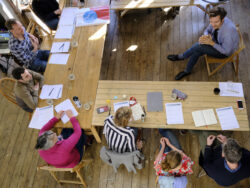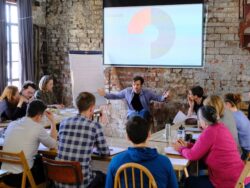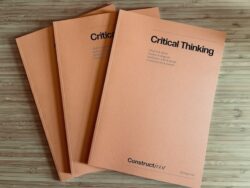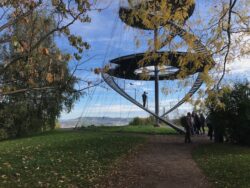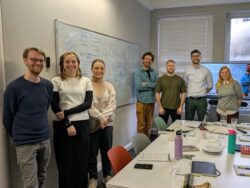Last week, we were at the Institution of Structural Engineers delivering our ‘How to Have Ideas’ workshop to graduate engineers from Ridge Consulting.
Creative thinking is often the gap in the formal education and training of engineers. Yet, in the context of the climate emergency and a rapidly changing economy, creative thinking is crucial for developing designs that meet the needs of people and our wider ecology.
Making the Case for Divergent Thinking
Our ‘How to Have Ideas’ course gives participants a simple model for how we have ideas, and a series of techniques to structure creative thinking in the early stages of a project. We open with the idea that we spend lots of time learning as engineers to optimize designs, but very little time learning how to have a good range of ideas to start off with. We liken the scenario to blindly applying an optimizing algorithm in a solution field and reaching a local maximum, without ever realizing that there might be a much greater peak if we set off in a different direction.
Having established the need for divergent thinking, we split the remainder of the workshop into two parts of our idea-generating model: gathering a sufficiently divergent set of inputs and then finding ways to create novel connections between those inputs.
Don’t Just Do Something, Sit There
At the end of the workshop, we ask participants to think about how they can weave these techniques into their daily practice as engineers. The biggest idea to emerge from this last discussion was that when a new project arrives, we often just get on with finding the answer without making the time to think creatively about the response. In an inversion of the old saying: don’t just do something, sit there.
There was a great atmosphere in the workshop. I really appreciated how the engineers from Ridge Consulting engaged with the exercises.
More Courses Like This
The concepts in the ‘How to Have Ideas’ course are at the core of our conceptual design teaching at Constructivist. There is a strong overlap with our ‘Introduction to Conceptual Design for Structural Engineers’ and it is strongly referenced in our ‘Advanced Conceptual Design for Team Leaders’ course.
We also run ‘How to Have Ideas’, ‘Introduction to Conceptual Design’, and ‘Advanced Conceptual Design’ as in-house courses for organizations, either delivered online or face-to-face. If you are interested, then get in touch via LinkedIn.


